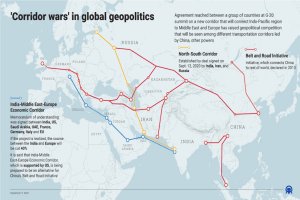Iran’s geographical position and infrastructural capabilities make it a pivotal hub for international transport corridors. Connecting East Asia, South Asia, and Europe, Iran offers a shorter, cost-effective, and strategically advantageous route for trade and transport. With the rise of global trade and the need for efficient supply chains, Iran’s transport corridors have garnered increasing attention.
Geostrategic Location
Iran is uniquely positioned between three major regions: East Asia, South Asia, and Europe. It serves as a bridge connecting the Indian Ocean, the Persian Gulf, and the Caspian Sea to Central Asia and Europe. This makes it a key transit point for global trade networks, including the North-South Transport Corridor (NSTC) and the Silk Road Economic Belt.
The NSTC, for example, reduces transit time and costs for goods traveling from India to Russia and Europe via Iran. According to the International Road Transport Union (IRU), the corridor slashes transit time by up to 40% compared to traditional routes via the Suez Canal. Similarly, the China-Europe trade network benefits significantly from Iran’s connectivity to Central Asia and the Caucasus (IRU, 2023).
Advantages Over Competing Routes
1. Reduced Transit Time
Iran provides a faster route compared to alternatives like the Suez Canal or Trans-Siberian Railway. For instance, cargo shipped via the Chabahar-Zahedan rail and road network can reach Bandar Abbas and then transit to Europe or Russia significantly quicker (Asian Development Bank, 2022).
2. Lower Costs
Iran’s integrated network of highways, railways, and ports reduces transportation costs. The investment in projects like the Chabahar Free Trade Zone further enhances its competitive edge over the UAE and other Gulf Cooperation Council (GCC) countries (World Bank, 2022).
3. Strategic Connectivity
Iran’s ports, such as Bandar Abbas, Chabahar, and Anzali, provide seamless links to international markets. Chabahar, for instance, offers direct access to the Indian Ocean and bypasses Pakistan’s bottlenecks for India’s trade with Central Asia and Europe (Ministry of Commerce, India, 2023).
North-South Transport Corridor (NSTC): A Case Study
The NSTC is a multimodal transport network stretching from India to Europe via Iran and Russia. It integrates rail, road, and sea routes, reducing dependency on the lengthy Suez Canal route. Key nodes in Iran, such as Bandar Abbas and the Caspian Sea ports, play crucial roles in facilitating cargo movement. A study by the Economic Cooperation Organization (ECO) highlights that the NSTC is up to 30% cheaper than the traditional shipping routes (ECO, 2021). Moreover, the corridor has proven resilient to geopolitical tensions, with Iran consistently upgrading its infrastructure to support uninterrupted trade flows.
Challenges and Iran’s Efforts to Overcome Them
Despite its advantages, Iran faces challenges, such as sanctions and infrastructure gaps. However, significant efforts have been made to mitigate these issues:
- Investment in Infrastructure: Projects like the Tehran-Qazvin-Rasht-Astara railway enhance connectivity to Azerbaijan and Russia.
- Strategic Partnerships: Iran collaborates with countries like India, China, and Russia to strengthen its trade routes. For instance, the Chabahar Agreement between India and Iran exemplifies efforts to bypass geopolitical hurdles (Ministry of Transport, Iran, 2023).
- Streamlining Customs Processes: The Iranian government has reformed customs regulations to facilitate faster and more transparent border crossings, as noted by the IRU in 2023.
The Role of Chabahar Port
The Chabahar Port serves as a linchpin in connecting South Asia, Central Asia, and Europe. It is particularly significant for India’s trade with Afghanistan and Central Asia, bypassing Pakistan. A report by the Indian Institute of Foreign Trade states that Chabahar can reduce India’s shipping costs to Europe by up to 20% (IIFT, 2022). The port’s strategic position allows it to connect to the Zahedan railway and onward to Iran’s national rail network, linking the Persian Gulf with the Caspian Sea and beyond.
Future Prospects
Iran is poised to play an even greater role in global trade as international focus shifts towards more efficient and sustainable transport corridors. The development of the East-West Corridor linking China to Europe via Iran is a testament to this. China’s Belt and Road Initiative (BRI) has also recognized Iran as a critical juncture for its land and maritime trade routes (Belt and Road Forum, 2023).
Iran’s geostrategic location, infrastructural advancements, and cost-effective routes make it the best choice for connecting East Asia, South Asia, and Europe. While challenges remain, Iran’s ongoing investments in transport corridors and international partnerships solidify its position as a global trade hub. The realization of Iran’s full potential as a transport corridor will not only benefit the country but also streamline trade for nations across Asia and Europe, fostering economic growth and regional integration.
References
- Asian Development Bank. (2022). Transport Corridor Development in the Middle East.
- Economic Cooperation Organization (ECO). (2021). North-South Transport Corridor: Efficiency and Economic Impact.
- International Road Transport Union (IRU). (2023). Trade and Transport Corridors: Global Perspectives.
- Ministry of Commerce, India. (2023). Chabahar Port: India’s Gateway to Central Asia.
- World Bank. (2022). Trade and Logistics in the Middle East.
- Belt and Road Forum. (2023). China’s BRI and Iran’s Role.


